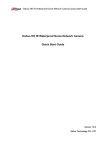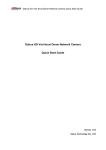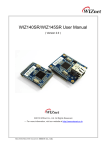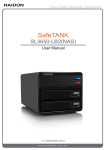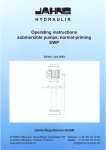Download F Series Indoor IP User`s Manua
Transcript
HD Fisheye Panorama Network Camera Quick Start Guide Version 1.2.0 i Welcome Thank you for purchasing our network camera! This user’s manual is designed to be a reference tool for your system. Please read the following safeguard and warnings carefully before you use this series product! Please keep this user’s manual well for future reference! 1.Electrical safety All installation and operation here should conform to your local electrical safety codes. Please check if the power supply is correct before operating the device. The power shall conform to the requirement in the SELV (Safety Extra Low Voltage) and the Limited power source is rated 12V DC, DC5V or AC24V in the IEC60950-1. (Power supply requirement is subject to the device label). Please install easy-to-use device for power off before installing wiring, which is for emergent power off when necessary. Please prevent the line cord from being trampled or pressed, especially the plug, power socket and the junction from the device. Note: Do not connect these two power supplying sources to the device at the same time; it may result in device damage! We assume no liability or responsibility for all the fires or electrical shock caused by improper handling or installation. We are not liable for any problems caused by unauthorized modification or attempted repair. 2.Environment Please don’t aim the device at strong light (such as lighting, sunlight and so on) to focus; otherwise it may cause overexposure (It is not the device malfunction), which will affect the longevity of CCD or CMOS. Please transport, use and store the device within the range of allowed humidity and temperature. Please don’t keep the device in a place which is wet, dusty, extremely hot, and extremely cold and with strong electromagnetic radiation or unstable lighting. Please do not allow water and other liquid falling into the camera in case that the internal components are damaged. Please do not allow rain or damp to the indoor device in case fire or lightning may occur. Please keep the sound ventilation in case of heat accumulation. Please pack the device with standard factory packaging or material with same quality when transporting the device. i Heavy stress, violent vibration or water splash are not allowed during transportation, storage and installation. 3. Operation and Daily Maintenance Please do not touch the heat dissipation component of the device directly in order to avoid scald. Please do not dismantle the device; there is no component which can be fixed by users themselves in the machine. It may cause water leakage or bad image for the device due to unprofessional dismantling. It is recommended to use the device with thunder proof device in order to improve thunder proof effect. The grounding holes of the product are recommended to be grounded to further enhance the reliability of the camera. Do not touch the CCD (CMOS) optic component directly. You can use the blower to clean the dust or dirt on the lens surface. Please use a dry cloth wetted by alcohol to wipe away the dust gently if it is necessary to clean. Always use the dry soft cloth to clean the device. If there is too much dust, please use the water to dilute the mild detergent first and then use it to clean the device. Finally use the dry cloth to clean the device. Don’t use volatile solvent like alcohol, benzene, thinner and etc or strong detergent with abrasiveness, otherwise it will damage the surface coating or reduce the working performance of the device. Dome cover is an optical device, please don’t touch or wipe cover surface directly during installation and use, please refer to the following methods to deal with once dirt is found: Stained with dirt Use oil-free soft brush or hair dries to remove it gently. Stained with grease or fingerprint Use soft cloth to wipe the water drop or oil gently to make it dry, then use oil-free cotton cloth or paper soaked with alcohol or detergent to wipe from the lens center to outward. It is ok to change the cloth and wipe several times if it is not clean enough. Warning Please use the standard accessories provided by manufacturer and make sure the device is installed and fixed by professional engineers. Please prevent the device surface from the radiation of laser beam when using laser beam device. Please do not provide two or more power supply modes for the device, otherwise it may cause damage to the device. Statement ii Please refer to the actual product for more details; the manual is just for reference. The manual will be regularly upgraded according to the product update; the upgraded content will be added in the manual without prior announcement. Please contact the supplier or customer service if there is any problem occurred when using the device. Please contact the customer service for the latest procedure and supplementary documentation. There may be deviation between the actual value of some data and the value provided in the manual due to the reasons such as the real environment is not stable and so on. Please refer to the company’s final explanation if there is any doubt or dispute. The company is not liable for any loss caused by the operation which is not followed by the manual. Before installation, please open the package and check all the components are included. Contact your local retailer ASAP if something is broken in your package. Accessory Name Amount Network Camera 1 Quick Start Guide 1 Installation Accessories Bag 1 CD 1 iii Table of Contents 1 Structure ..................................................................................................................... 1 1.1 Device External Cables ............................................................................ 1 1.2 Dimensions .................................................................................................. 2 1.3 Bidirectional Talk ........................................................................................ 3 1.3.1 Device-end to PC-end ....................................................................... 3 1.3.2 PC-end to Device-end ....................................................................... 3 1.4 2 3 Alarm Setup................................................................................................. 4 Installation .................................................................................................................. 6 2.1 Device Installation ...................................................................................... 6 2.2 Micro SD Card Installation ....................................................................... 8 Network Configuration ............................................................................................. 9 3.1 Modify IP Address ...................................................................................... 9 3.2 Login WEB Interface ............................................................................... 10 iv 1 Structure 1.1 Device External Cables Note: The following figures are for reference only, which are used to know each structure component and cable port function. Different models may have different structure components and cables, please refer to the actual product for more details. Figure 1-1 Please see Sheet 1-1 for more details about external cable functions. SN Port Port name Connector Function Description 1 LAN Network port Ethernet port Connect to standard Ethernet cable. 2 POWER - Connect to DC 12V power, input power. 3 AUDIO OUT Audio output port RCA Output audio signal to speaker and other devices. 4 AUDIO IN Audio port RCA Input audio signal, receive analog audio signal from pick-up and other devices. 5 I/O I/O port - Connect I/O port. Power input port input Sheet 1-1 See Sheet 1-2 for more details about I/O port functions. Port Name Port SN Port Connector name 1 ALARM_IN1 2 ALARM_OUT1 Function Description Alarm input port, receive the on-off signal from external alarm source. I/O Port Alarm output port, output alarm signal to alarm device. 1 Port Name Port SN Port Connector name Function Description 3 ALARM_GND GND Sheet 1-2 1.2 Dimensions Note: The following figures are for reference only; different models may have different appearances according to the figures below, please refer to the actual product according to Figure 1-2 to Figure 1-4. Figure 1-2 Figure 1-3 2 Figure 1-4 1.3 Bidirectional Talk 1.3.1 Device-end to PC-end Device Connection Please connect the speaker or the MIC to the audio input port of the device, and then connect the earphone to the audio output port of the PC. Login the Web and then click the “Talk” button to enable the bidirectional talk function. You can see the button becomes orange after you enabled the bidirectional talk function. Click “Talk” button again to stop the bidirectional talk function. Listening Operation At the device end, input the voice info to the speaker or MIC, and then receive the voice info sent via earphone and other devices at the pc-end. 1.3.2 PC-end to Device-end Device Connection Please connect the speaker or the MIC to the audio input port of the PC, and then connect the earphone to the audio output port of the device. Login the Web and then click the “Talk” button to enable the bidirectional talk function. You can see the button becomes orange after you enabled the bidirectional talk function. Click “Talk” button again to stop the bidirectional talk function. Bidirectional talk function and on-site listening function can’t be used at the same time for the device. Listening Operation At the pc end, input the voice info to the speaker or MIC, and then receive the voice info sent via earphone and other devices at the device-end. 3 1.4 Alarm Setup Note: Alarm function is only supported by some models. Please refer to Figure 1-5 for more details. Figure 1-5 Please follow the steps listed below for alarm input and output connection. Step 1 Connect alarm input device to the alarm input of I/O cable. Step 2 Step 3 Connect alarm output device to the alarm output of I/O cable, alarm output is collector open circuit output which connects 10K resistor to 3.3V externally. Open the Web, set alarm input and output correspondingly. Alarm input on WEB Step 4 corresponds to I/O cable on device. When there is alarm, alarm input device will generate signal of high and low level. Set corresponding NO and NC inputs. Set the WEB alarm output. The alarm output is for the alarm output port of the device. It is the alarm output port of the I/O cable. Alarm input, output figures: Figure 1-6 Alarm input: When the input signal is idle or grounded, the device can collect the different statuses of the alarm input port. When the input signal is connected to 3.3V or it is idle, the device collects the logic “1”. When the input signal is grounded, the device collects the logic “0”. 4 Figure 1-7 When alarm output is OC, it needs to increase pull-up resistance externally to work normally; output signal is high and low level. After external pull-up resistance is increased, the default of output signal is high level, and it switches to low level when there is alarm output. The working current of alarm output port is recommended as <= 10mA. The max current which is used to drive external circuit is 80mA, it is advised to add a relay if it is beyond the value. 5 2 Installation Important Before the installation, please make sure the installation surface can sustain at least 3X weight of the bracket and the camera. 2.1 Device Installation Installation Position Map Ceiling Mount Effect Wall Mount Effect Figure 2-1 6 Figure 2-2 Step 1 Use the inner hex wrench from the accessories bag to unfasten the 3 hex screws on the dome camera enclosure and then open the dome enclosure. Step 2 Take the installation position diagram from the accessories bag and then paste it on the installation ceiling or the wall according to the monitor area. Please dig three bottom holes of the plastic expansion bolts according to the diagram. Take three expansion bolts from the accessories bag and then insert them to the holes you just dug and then fix firmly. Note: If you need to dig a hole to pull through the cable on top of installation surface, you need to dig a cable exit hole on the installation surface according to the installation positioning diagram. If you need to pull through the cable on the side, you need to dig through the U-shape exit hole on the side of chassis to form a cable access, and then pull the cable through the side exit hole on the chassis. Step 3 Adjust the device chassis and pull the cable through the exit hole. Make “TOP” direction of the device identical with installation diagram. Make sure the 3 fixture holes on chassis face the three plastic expansion bolts on the surface. Take 3 self-tapping screws out from the accessories bag and fix them on the three plastic expansion bolts to secure the dome on installation surface. Step 4 Take up the dome protection enclosure; aim the cable exit and cover the enclosure. Then use the inner hex wrench from the accessories bag to fasten the 3 hex screws. So far installation is completed. Note: 7 Please refer to Micro SD card installation steps if you need to install Micro SD card, and operate step 4 after the installation. Connect the host GND to ground lead, which may improve device reliability. The GND locates next to exit hole on the rear side of the chassis and the GND screw is M3. 2.2 Micro SD Card Installation Take down the 3 inner hex screws on the upper enclosure by using the inner hex wrench in the accessories bag, find the location of Micro SD card slot according to the following figure, and fasten the 3 screws on the upper enclosure after inserting Micro SD card. Note: Please make sure the wire connection between power panel and device motherboard is firm, otherwise it may cause abnormity. Make sure the 3 screws are fastened firmly after installation to prevent dust for the device. Figure 2-3 8 3 Network Configuration The IP address of all the cameras is the same when leaving factory (default IP192.168.1.108), in order to make the camera get access to the network smoothly, please plan the useable IP segment reasonably according to the actual network environment. 3.1 Modify IP Address IP address can be acquired and modified through quick configuration tool for the cameras which are accessed via wired network, it needs to connect wired network to configure wireless parameters before using wireless network cameras. In this chapter, it will introduce the approach of modifying IP address via “Quick Configuration Tool”; also you can modify the IP address in the network parameters of the WEB interface, please refer to the document in the disk << WEB Operation Manual>> for more details. Note: Currently the quick configuration tool only supports the cameras which apply to the same network segment with computer IP address. Step 1 Double click the “ConfigTools.exe” and open the quick configuration tool. Step 2 Double click the device to be configured, the system will pop out the “Login” dialog box. Enter the IP address, user name, password and port number of the camera, and click “Confirm”. Note: The default user name and password are admin and admin respectively, the default of port is 37777. See Figure 3-1 for more details. 9 Figure 3-1 Step 3 Modify the camera IP address on the “Net” interface, click “Save” to finish modification. See Figure 3-2 for more details. Figure 3-2 3.2 Login WEB Interface Note: Different devices may have different WEB interfaces, the figures below are just for reference, please refer to the document <<WEB Operation Manual>> in the disk and the actual interface for more details Step 1 Open IE and input the modified camera IP address in the address bar. Step 2 The login interface is shown below, please input your user name and password (Default user name is admin and password is admin respectively), click “login”. See Figure 3-3 for more details. 10 Figure 3-3 Step 3 Install controls according to the system prompt; see Figure 3-4 for the WEB main interface. Please modify the administrator password as soon as possible after you successfully logged in. Figure 3-4 11 Note This user’s manual is for reference only. Slight difference may be found in user interface. All the designs and software here are subject to change without prior written notice. All trademarks and registered trademarks mentioned are the properties of their respective owners. If there is any uncertainty or controversy, please refer to the final explanation of us. Please visit our website for more information. 12


















